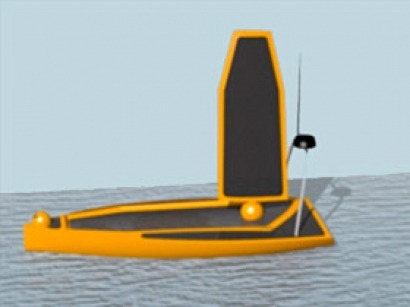
The licence agreement between the two companies combines SolarSailor’s patented Unmanned Ocean Vessel (UOV) technology with Forgacs’ track record in major Navy and commercial ship building, which the partners hope will lead to the development of a “game-changer for the $2 billion worldwide UOV market”.
“Other types of UOV currently in use deploy at sea for hours or days only, and use strictly finite amounts of on-board stored fossil-fuel or solar generated electric power for propulsion,” explains Robert Dane, CEO Solar Sailor and the technology’s inventor.
“The SolarSailor UOV offers unlimited time-at-sea with the primary propulsion being wind (with the SolarSail) for the vessel’s movement, and renewable-electricity generated at sea from propeller regeneration. Photo Voltaic cells on the SolarSail power all electronics such as steering, lighting, movement sensors and satellite communications.” Dr Dane said.
An abundant reserve electrical power is stored in Lithium Ion battery packs low down in the hull, which also act as ballast to balance the vessel. “This opens a whole new suite of capabilities and markets in highly-sensitive security or weather-risk areas, in military operations and coastal border protection with unauthorized maritime arrivals, oceanography and meteorology, and marine safety at sea,” adds Dane.
The vessel requires no fossil fuels to operate and gives off zero-emissions. Photovoltaic solar cells cover the stowable aerofoil type wingsail and much of the deck. The propeller is driven by an electric motor (without engine noise) and is used in low-wind-conditions for manoeuvring, collision avoidance, and stealth missions.
These unique vessels offer a quantum change in maritime operations with worldwide implications according to Tony Lobb, Director of Forgacs. “Navies and coastguards worldwide can enjoy limitless at-sea operation and vessel-monitoring from on-shore, without risk to crew safety, and with large, variable payload capacities at low capital cost, and low running costs without the need for on-board crew or renewing fossil fuels, and this proven Solar Sailor technology is already powering six vessels in Hong Kong, Shanghai and Australia.”
US military interest
While SolarSailor and Forgacs profess to be there first, other projects are also being rolled out around the world to find alternative energy solutions for UOVs. Since 2008, the John Hopkins University Applied Physics Laboratory (JHU/APL) has been developing an autonomous sailing vessel for tactical ocean surveillance as part of the Defense Advance Research Projects Agency’s (DARPA) Persistant Ocean Surveillance Program.
Named the ‘Station-Keeping Buoy’, the vessel is capable of extracting wind, water turbine and solar energy from the local environment for long-term station keeping. The prototype testing of the ‘SKB’ was conducted on local rivers and in near-shore ocean environments.
The systems and functionalities of the SKB, which incorporate Iridium communications, solar energy harvesting, a wind-dumping sailing rig and an acoustic data processing and tone detection system have all been proven to work successfully, and the battery voltage was shown to increase over five hours, proving that it had successfully harvested solar energy.
Stalking enemy submarines
The US military has also made no secret of its vision to field an ever increasing number of automated and unmanned vehicles onto the battlefield. The use of these vehicles reduces the risk to human life and without a human aboard the vehicle, the design can be better optimised for the mission.
Such is its commitment to developing UOVs that the US Navy has stumped up $10 million in research and development funds to help the company Harbor Wind Technologies develop its unmanned watercraft, the Harbor Wing.
A prototype of the triple-hulled unmanned vessel, dubbed X-1, has been plying the waters off Pearl Harbor, Hawaii, for several years as a concept vehicle and is described as “a seagoing robot that provides the eyes and ears – and information and intelligence – without the need for humans aboard”.
Now, with the US Navy’s backing, the company will take a new X-2 prototype out of San Diego Bay this autumn for the open waters of the Pacific Ocean in a show of the potential of unmanned watercraft.
The 40-by-50-foot, 10-ton craft is unique, defined by three innovative components: the WingSailTM, the Hydrofoils, and the Guidance System, and will meet fundamental requirements of military, government, and commercial customers by providing situational awareness to operational commanders. It can be used for everything from drug interdiction and search and rescue through to marine mammal monitoring, undersea oil and gas exploration and ocean survey and mapping.
“I’ve removed the sailor from the sailing,” says Mark Ott, Executive Vice President of Harbor Wing Technologies, who built the first Harbor Wing prototype with a regular catamaran he bought for $12,000.
For additional information:

